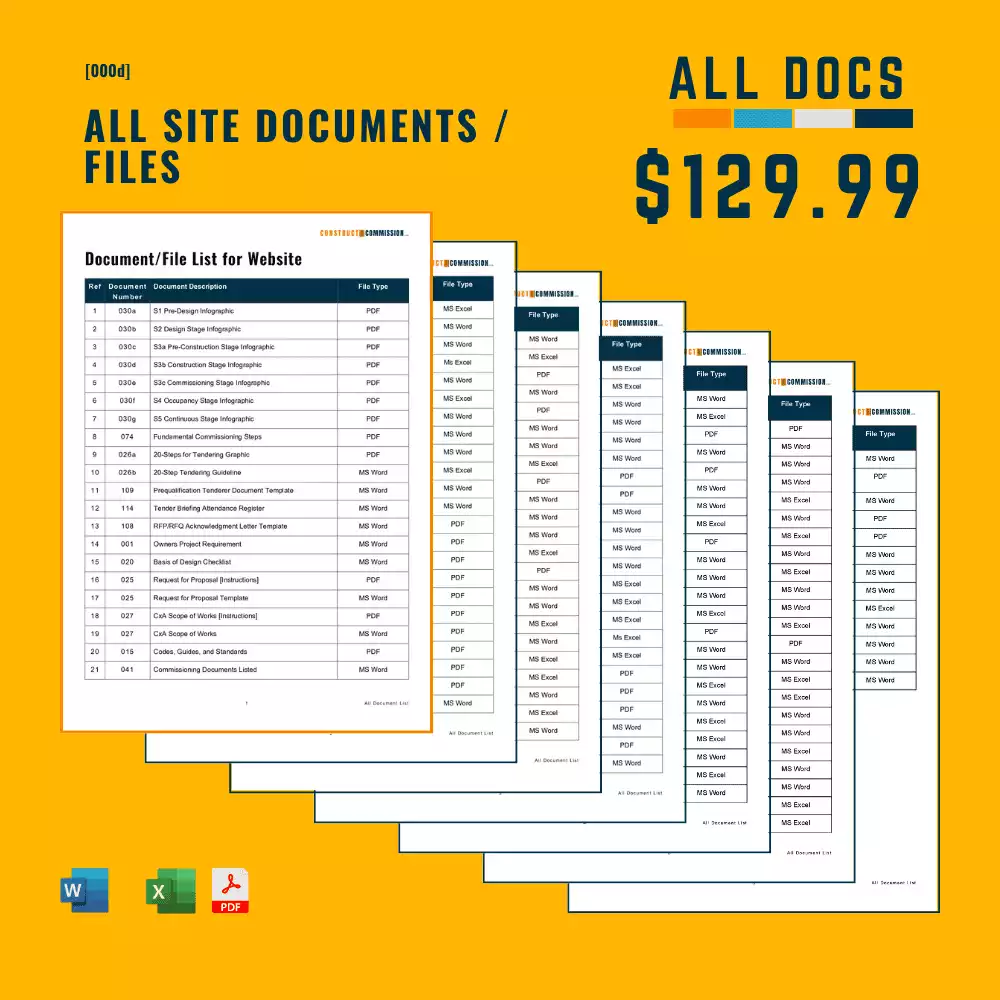Lessons learned form part of the overall construction/commissioning process that allows the team to document and share the insights, successes, challenges, mistakes, and recommendations gained during the project to improve any future projects, knowledge, collaboration, communication, and overall project performance.
To ensure the process and information is well documented, a report will be created and managed throughout the program, then finally concluding with a workshop.
In this article, we will examine their value, and provide a guide on how to conduct them, including timelines, responsibilities, and best practices.
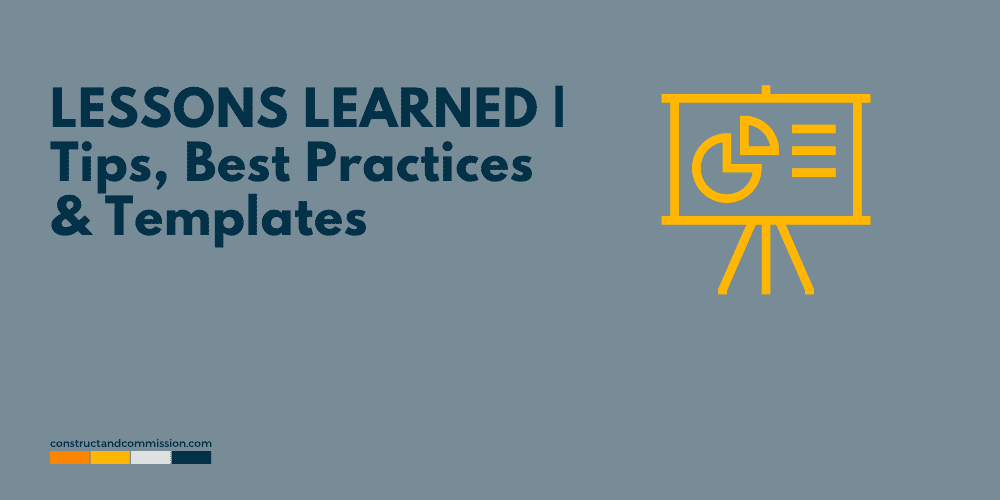
🟩 12 Beneficial Reasons they are Conducted

There are many reasons to conduct a Lessons Learned process, below we have included 12 of the most common ones:
- Identifying and avoiding potential risks and mistakes: The process allows the project team to identify and address challenges and mistakes made during the project, which will help improve future projects by avoiding these same mistakes.
- Improved communication and collaboration: having all stakeholders involved in the process will help to improve communication and collaboration among project team members.
- Increased efficiency: Understanding and addressing the challenges and mistakes made during the current project, the process can help drive and increase efficiency for any future projects.
- Improved overall project performance and outcomes: The project team can identify and address challenges and mistakes made during the project, which will help improve overall project performance and outcomes.
- Identifying best practices: Gives an opportunity to identify best practices that can be used and followed for future projects.
- Identifying areas for improvement: The project teams are able to identify areas of the project and processes that need improvement, used again to help future projects.
- Improving reference material and project documentation: Creating a well-written document and report, including in-depth information can serve as a great reference for the future and facilities department to reference during the operation of the building.
- Better learning experience: By involving all team members in the process, the overall project can participate in providing and receiving feedback and input from many different perspectives, resulting in a better learning experience.
- Greater accountability: By running a comprehensive lessons-learned process will help promote accountability and identify who is responsible for the tasks, actions, and outcomes, allowing the project team to learn and make improvements.
- Greater effectiveness in resource allocation: Identifying and addressing the items can help the project team to make effective use of the resources.
- Greater potential for creativity: If run correctly, the process will encourage the team to think critically about their work and consider new solutions.
- Greater potential for cost savings: Addressing challenges and any mistakes/issues made during the project helps the team to achieve greater potential cost savings for future projects.
🟩 Lessons Learned Timeline

The Lesson Learned process will start at the project inception, this is due to it being included within the overall pre-design stage of the commissioning process. For the project team, it is completed upon handover of the building to the facilities department, which will take the information and keep updated throughout the building’s operational life.
🟧 Beginning of the Project
At the beginning of the project, usually, in the ‘pre-design stage’ the commissioning manager should start the ‘Lessons Learned’ process, including holding project teams should start preparing for a “lessons learned” report and workshop by outlining the process and identifying the key stakeholders who will be involved. This will ensure that the process is in place and ready to be executed at the end of the project.
🟧 During the Project
Throughout the project, the overall management team, led by the commissioning manager, should document and track all items included within the ‘Lessons Learned’ document, including the successes, challenges, and issues noted across the project as they occur.
The document should also be reviewed regularly to ensure it is kept up-to-date and represents the current project status.
🟧 Before Handover
Toward the end of the project and before the handover the team should conduct a ‘lessons learned’ workshop, see that will involve all the project stakeholders and used to discuss in an open forum the lessons between all these parties.
Once the ‘lessons learned’ workshop has been completed and all parties are in agreement, the commissioning manager will document the discussions and the outcomes, then write the ‘Final Lessons Learned Report’, sharing it with the team and updating any central databases with the info, closing out this element of the work.
🟧 After Handover
Once the project is fully handed over to the building operations team, it’s the end of the process for the project team but not the document.
Like with the Training Manual, the Lessons Learned information should be reviewed and updated at regular intervals by the operator to ensure that it reflects the current status of the facility and that it is accurate.
🟩 How to run a ‘Lessons Learned’ Workshop

Conducting an effective workshop is a critical step in the process, as it allows all participants the chance to come together and share their experiences, insights, and feedback.
A well-planned and run workshop will help identify key issues, successes, and areas that could have been improved in the project, providing recommendations for future works and projects.
When planning a workshop, it’s important that we set clear objectives and topics for the session, as noted in the agenda below, and to involve all relevant stakeholders, as per the participant’s list.
Participation of the attendees in the workshop will be key to ensuring a successful workshop. This can be achieved by encouraging open communication, actively seeking input from all attendees, and fostering an environment where all voices are heard and none are blamed.
Once the workshop is concluded, recording the outcome, feedback, and recommendations will need to be completed to ensure that the process is fully closed out.
This will usually be done by the commissioning manager who will take notes to record the session, and summarize the key points discussed. This information will then be used to write and create the final lessons learned recommendations and report.
Finally, once the workshop is concluded, it’s important that the team follows up and takes action on any tasks and activities that have been agreed upon, and where required a closeout plan should be created and implemented, this can be part of the overall final report.
Here are our Templates that can be downloaded and used covering
Lessons Learned Tracker Template | Lessons Learned Agenda & Minutes Template | Lessons Learned Final Report Template
All in Microsoft Word and Excel for use straight away
🟩 Template Lessons Learned Workshop Agenda
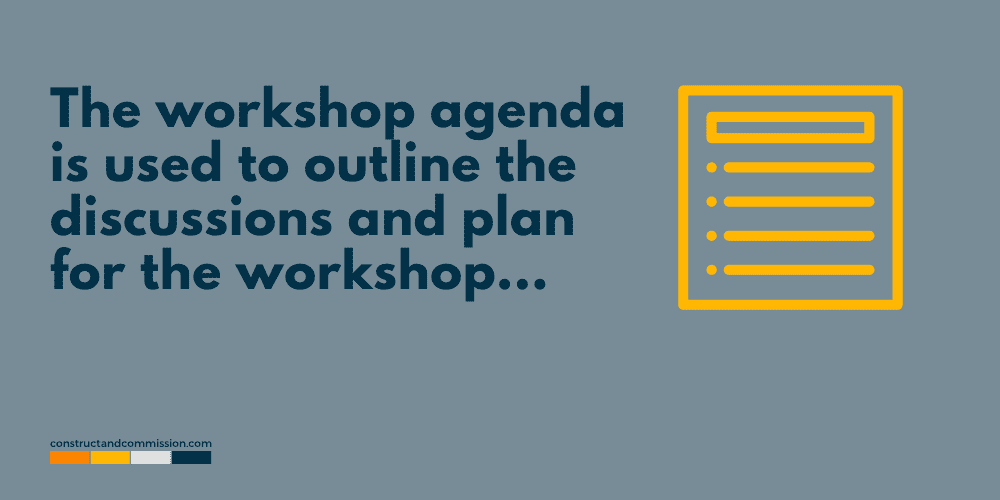
The “Lessons Learned” workshop agenda is produced by the commissioning manager and is used to outline the discussions and plan for the workshop, allowing the participants to plan accordingly.
It will typically include the following information:
- Project, Date, Time, and Location
- Introduction,
- Agenda,
- Participants,
- Format,
- Materials,
- Follow-up.
🟧 Project, Date, Time, Location
Include core information to allow the readers to understand what the workshop is for, when it will be held and where.
Project: This will be the Project/Building Name,
Date: The date when the Workshop will be held,
Time: The time the workshop will be held,
Location: Where the workshop will be held. Physical or remote.
🟧 Introduction
Provide a brief overview of the purpose of the workshop and the expected outcomes.
This will allow the participants to understand why they are participating in the workshop, and what they can expect to gain from it.
🟧 Agenda
Include a section that details the list of topics that will be covered during the workshop, including the time allocated for each topic.
The main body of the agenda should provide a list of topics that will be discussed during the workshop, along with the allocated time for each topic.
This will give attendees an idea of what will be covered, allowing them to prepare accordingly.
Topics could be focused on specific aspects of the project such as project management, design, or construction, and could include exercises, presentations, or group discussions.
🟧 Participants
Including a list of participants and attendees that are to be at the workshop, including their role in the workshop will allow them to understand who will be present, and what their level of involvement will be.
The types of people that would generally be present are:
- Owner,
- Facilities Manager,
- Project Manager,
- Quantity Surveyor, [why?, because they can bring other experiences regarding areas and processes that do not usually get talked about in these types of things, Costs/Money]
- Commissioning Manager [Chair],
- MEP Design Manager,
- Project Programmer [why?, because they can bring other experiences regarding areas and processes that do not usually get talked about in these types of things, Time and Programme].
- General/Main Contractor
- Sub Contractor,
- Vendors.
🚀 If the Sub Contractors and Vendors are not to be included, then the General/Main Contractor should perform their own internal lessons learned workshop to provide them with the opportunity to raise any key points.
🟧 Format
This will include information on the format of the workshop, such as whether it will be a presentation, discussion, or group exercise.
Could be a combination of all three.
🟧 Materials
Include a list of any materials that will need to be available and used during the workshop. Items can include:
- equipment,
- projectors,
- whiteboards,
- flip charts,
- handouts,
- presentations,
- worksheets,
- reports,
- trackers etc.
Should also include who is to provide, this will ensure there is no confusion.
🟧 Follow-Up Actions
Follow-up actions that will be taken after the workshop should be noted.
This may include creating a report, implementing recommendations or scheduling a follow-up meeting.
🟩 Lessons Learned Document Formats and Templates
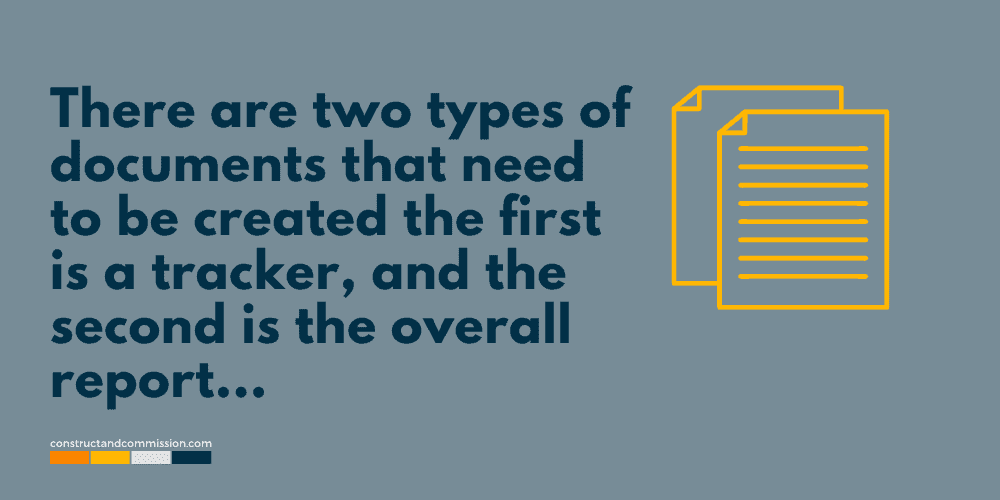
There are two types of documents that need to be created the first is the lessons learned tracker, and the second is the overall report, which the tracker will be incorporated into.
🟧 Lessons Learned Tracker
The tracker will be created, in an excel format, at the start of the overall commissioning process to ensure that lessons and resolutions are captured and documented early, ensuring that later when the workshops are conducted we are not trying to remember things that happened months ago.
The columns would usually cover the following:
- Project information – building, location,
- Lesson learned issue ID number,
- Date of issue noted,
- Status of issue – this would be in the form of ‘open/closed/in progress’,
- Phase of project – this could reflect the commissioning phases,
- Issue description – include a brief description of the issue that was identified.
- Impact of the issue – including any delays, cost impacts, or other negative effects.
- Root cause – including the underlying cause of the issue such as ‘communication, tender, design, coordination etc’.
- Responsible party – the person or group responsible for managing and closing out the issue,
- Resolution – this should provide a high-level overview of how the observation/issue was managed and closed out. Including timelines, actions, and dates,
- Lessons Learned – insert key insights and lessons that were learned as a result of the issue, including recommendations for future projects.
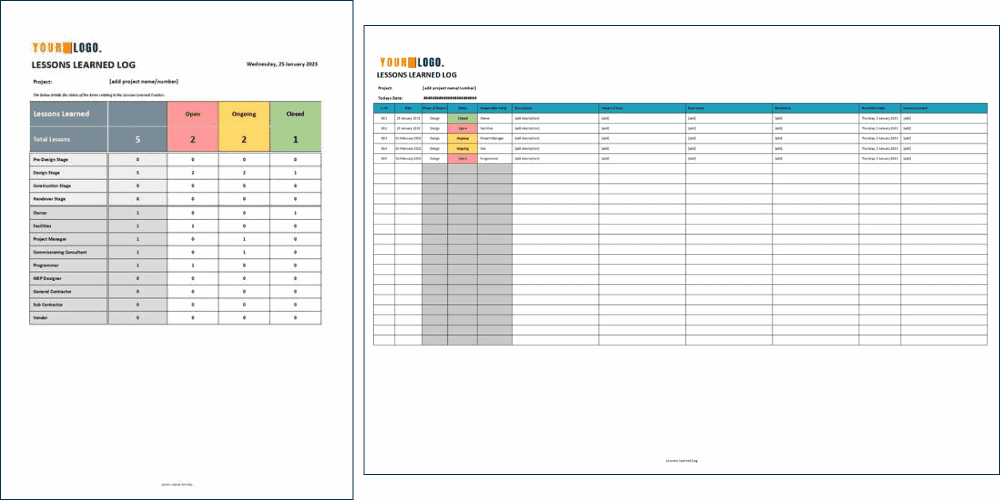
🟧 Lessons Learned Report Format
The lessons learned report, usually created in Microsoft word, is used to document and share the information and insights gained during the project at the closeout stage.
Headings that would typically include:
- Executive summary – provides a summary of the key insights and lessons learned from the project, including recommendations for future projects.
- Introduction – overview of the project, including the project scope, objectives, and stakeholders.
- Project overview – include a description of the project, including the project timeline, budget, and key milestones.
- Issues and Lessons Learned – add a list of the issues that were identified during the project and the lessons that were learned as a result. This would be the ‘lessons learned’ tracker above.
- Recommendations – include a list of recommendations for future projects, based on the insights and lessons learned from the current project.
- Conclusion – provide a summary of the key takeaways from the project and the impact that the “Lessons Learned” process had on the project.
- Appendices – include any additional supporting documents, such as the tracker, workshop agendas, and meeting minutes.
🟩 Roles and Responsibilities
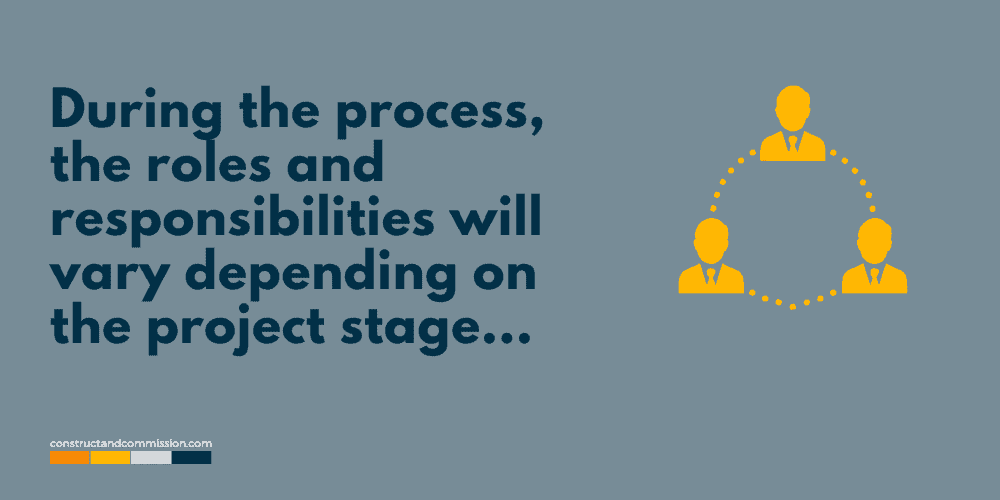
During the process, the roles and responsibilities will vary depending on the project stage as can be seen below.
The people involved are as per the participants listed in the section above.
| Stage | Role | Responsibility |
|---|---|---|
| Pre-Design Stage | Owner | Ensure CxA is onboard |
| Facilities Manager | ||
| Project Manager | ||
| Quantity Surveyor | ||
| Commissioning Manager | Instigate the Lessons Learned process, Create template tracker, Create template report. |
|
| MEP Designer | ||
| Programmer | ||
| General/Main Contractor | ||
| Sub-Contractors | ||
| Vendors | ||
| Design Stage | Owner | Input to Lessons Learned Document and Meetings, |
| Facilities Manager | Input to Lessons Learned Document and Meetings, | |
| Project Manager | Input to Lessons Learned Document and Meetings, | |
| Quantity Surveyor | Input to Lessons Learned Document and Meetings, | |
| Commissioning Manager | Lead Lessons Learned Process Discuss Lessons Learned with team regularly, Update Lessons Learned Document, |
|
| MEP Designer | Input to Lessons Learned Document and Meetings, | |
| Programmer | Input to Lessons Learned Document and Meetings, | |
| General/Main Contractor | ||
| Sub-Contractors | ||
| Vendors | ||
| Construction Stage | Owner | Input to Lessons Learned Document and Meetings, |
| Facilities Manager | Input to Lessons Learned Document and Meetings, | |
| Project Manager | Input to Lessons Learned Document and Meetings, | |
| Quantity Surveyor | Input to Lessons Learned Document and Meetings, | |
| Commissioning Manager | Lead Lessons Learned Process Discuss Lessons Learned with team regularly, Update Lessons Learned Document. |
|
| MEP Designer | Input to Lessons Learned Document and Meetings, | |
| Programmer | Input to Lessons Learned Document and Meetings, | |
| General/Main Contractor | Input to Lessons Learned Document and Meetings, | |
| Sub-Contractors | Input to Lessons Learned Document and Meetings, | |
| Vendors | Input to Lessons Learned Document and Meetings, | |
| Handover Stage | Owner | Attend Lessons Learned Workshop, Input to Lessons Learned Workshop, Sign Off Completion of the Lessons Learned Tracker and Report. |
| Facilities Manager | Attend Lessons Learned Workshop, Input to Lessons Learned Workshop, Continue to update Lessons Learned document and data-bases throughout the building life-cycle. |
|
| Project Manager | Attend Lessons Learned Workshop, Input to Lessons Learned Workshop, |
|
| Quantity Surveyor | Attend Lessons Learned Workshop, Input to Lessons Learned Workshop, |
|
| Commissioning Manager | Lead Lessons Learned Process Arrange Lessons Learned Workshop, Write and Issue Lessons Learned Agenda, Chair Lessons Learned Workshop, Update Lessons Learned Tracker, Write and Issue Lessons Learned Final Report, Lead Closeout and Follow-up of Lessons Learned Items, Update any Client Lessons Learned Data Bases, |
|
| MEP Designer | Attend Lessons Learned Workshop, Input to Lessons Learned Workshop, |
|
| Programmer | Attend Lessons Learned Workshop, Input to Lessons Learned Workshop, |
|
| General/Main Contractor | Attend Lessons Learned Workshop, Input to Lessons Learned Workshop, |
|
| Sub-Contractors | Attend Lessons Learned Workshop, Input to Lessons Learned Workshop, |
|
| Vendors | Attend Lessons Learned Workshop, Input to Lessons Learned Workshop, |
🟩 10 Steps to Completing a Successful ‘Lessons Learned’ Process

We have put together a 10-step ‘Lessons Learned’ process that can be referenced and used to help complete it on other projects effectively and efficiently. These steps will consist of the following:
- Step 1: Identify and Define the Lessons Learned Requirements,
- Step 2: Create the Team,
- Step 3: Agree on the Schedule and Agenda,
- Step 4: Identify and Document the Issues,
- Step 5: Conduct Regular Workshops and Meetings,
- Step 6: Involve all Participants,
- Step 7: Analyze and Document the Process,
- Step 8: Develop the Recommendations,
- Step 9: Create the Lessons Learned Reports,
- Step 10: Follow-up on Recommendations.
We have been asked several times to create a complete document package covering everything we have uploaded to the site.
So it's taken some time, but here it is....126No. Documents for you to download in Microsoft Word, Microsoft Excel & PDF Formats.
CLICK THE BUY HERE TO SEE/DOWNLOAD A FULL LIST OF DOCUMENTS INCLUDED...
🟧 Step 1 – Identify and Define the Lessons Learned Requirements
The first step will be to clearly establish the project goals and objectives.
By defining the project scope and objectives, we can ensure that the “Lessons Learned” process is aligned with the overall project expectations. This will help to make sure that the process is focused on the most important issues and that the information and insights gained are relevant to the project.
🟧 Step 2 – Create the Team
The next step is to assemble a team of relevant members to work on the process.
It’s important that each person knows their role and responsibilities in the process, to ensure that everyone is working towards the same goals and it is smooth and efficient.
🟧 Step 3 – Agree on the Schedule and Agenda
Creating an initial schedule, including workshops and meetings, is essential to making sure that the overall process runs well.
This will help to ensure that all stakeholders are aware of the requirements and their time/input allowing them to plan accordingly, and ensuring that the process stays on track.
🟧 Step 4 – Identify and Document the Issues
As issues arise and are noted during the project, it’s important to identify and document them regulary.
This will help to ensure that all issues are captured and that the ‘Lessons Learned’ process is focused on the most important issues.
🟧 Step 5 – Conduct Regular Workshops and Meetings
By conducting regular workshops and meetings prior to the final ‘Lessons Learned’ meeting at handover, we can ensure that all stakeholders are actively involved and that the process stays on track throughout the project.
🟧 Step 6 – Involve all Participants
Involving all relevant parties in the process, including the project team, client, end-users, and other key stakeholders will help to ensure that the process is inclusive and that all perspectives are taken into account. Helping make it a better outcome/learning.
🟧 Step 7 – Analyze and Document the Process
Evaluating the issues that have been noted and documenting the process, using the trackers and reports will help to ensure that the information and insights gained are relevant and actionable.
🟧 Step 8 – Develop Recommendations
It’s important to create recommendations for each ‘Lessons Learned’ item for future projects, this will help to avoid repeating the same mistakes creating a positive impact.
🟧 Step 9 – Create a Lessons Learned Report
Compiling all the information in a clear and concise report and making sure that it is shared with all relevant stakeholders, will help to ensure that the information and insights gained are documented and used effectively in the future.
🟧 Step 10 – Follow-up Recommendations
The final step in the process will be to implement the recommendations and follow up on their progress ensuring that they are implemented and improve future projects.
🟩 11 Common Observations

After conducting a few Lesson Learned processes we start to realize that there are common issues noted, no matter the project, below we have listed 11 of the ones we usually come across:
- Communication: Poor communication lead to misunderstandings and delays. Ensure that communication protocols are set up, agreed and incorporated into the project from the early stages.
- Unforeseen issues: Unexpected problems will occur, make sure to have a plan in place to deal with them immediately. This could be via agreeing with the project team on a process that should be followed with the key decision makers noted.
- Inadequate planning: Poor planning will lead to delays and increased costs. Ensure that the project is being driven from the outset and not waiting until the last 2 months to push.
- Lack of scope: Without a clear scope and objectives, gaps will arise causing issues throughout the project. It’s also hard to measure progress and success. Ensure the right people are involved in creating the scopes.
- Insufficient quality control: Quality issues can cause delays, program impact, cost impact, and client dissatisfaction. Place a rigid process into the project from the outset, ensuring all stakeholders are integrated and understand their roles.
- Coordination challenges: Managing multiple contractors and vendors can be difficult, but good coordination is paramount to ensuring success. Ensure that, from the early design stages the systems and equipment are being designed around the spaces available. Drawings will need to be clear and the installations coordinated in line with the correct sequence.
- Stakeholder engagement: Failing to involve key stakeholders can cause problems, especially when it comes to handover. Keep them involved throughout the process so that everyone arrives at handover with the same goals and expectations.
- Inadequate risk management: Lack of planning for risks can lead to negative consequences. Evaluate issues as and when they come up for risks, and be honest about the risk. Too many times we evaluate impacts as low risk, to make life easier when they can be high risk.
- Lack of training or skillsets: Without proper training or team members with the correct skillsets, team members can struggle to perform their roles, resulting in project impacts. Ensure that are involved and carrying out the work have the right experience and skillsets.
- Procurement challenges: Sourcing materials and equipment can be difficult, if not planned properly, and cause delays. Ensure that the delivery schedule is planned and understood from the outset, and do not just concentrate on large plants and equipment, smaller items such as cables and bus bars can have a significant impact on a project’s progress.
- Building systems issues: Difficulty in managing and operating building systems after handover can cause problems for the Facilities Team and the overall operation of the building. Ensure that a rigid and concise training programme is carried out and that they are fully confident in operating the building.
🟩 Codes/Guide & Standards

We can’t find any specific requirements when it comes to requirements of ‘Lessons Learned’ relating to Codes/Guides there are mentions of them in the following links:
- PMI’s A Guide to the Project Management Body of Knowledge (PMBOK® Guide)
- ISO 21500:2012 project management guidelines, it provides guidance on how to conduct “lessons learned” in project management
⬛ Related Articles
BUILDING LOG BOOK | What and Why?
TRAINING MANUAL | for Operational Staff at Handover with Template
AS-BUILT DRAWINGS | What are they?
LEVEL 6 – DATA CENTER Cx | Turnover & Handover


![Lessons Learned Templates [MS Word/Excel]](https://constructandcommission.com/wp-content/uploads/2023/01/125-PH-Lessons-Learned-Sell.webp)
